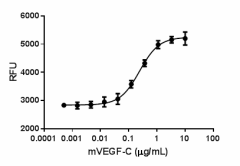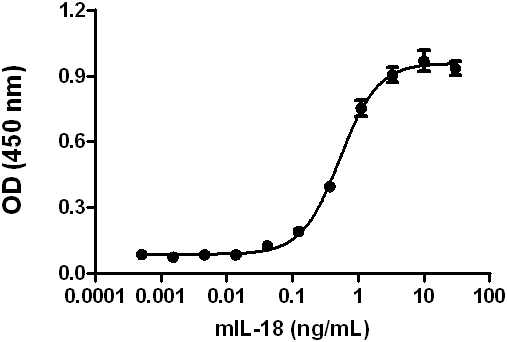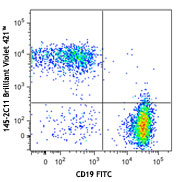- Regulatory Status
- RUO
- Other Names
- Vascular Endothelial Growth Factor C, VEGFC, Vascular Endothelial Growth Factor-Related Protein, VRP
- Ave. Rating
- Submit a Review
- Product Citations
- publications

-

Mouse VEGF-C induces proliferation of HMVEC human microvascular endothelial cells in a dose dependent manner. ED50 for this effect is 0.07 - 0.35 µg/mL. -

Stability testing for Mouse VEGF-C. Mouse VEGF-C was aliquoted in 10 mM Sodium Phosphate, 0.3 M NaCl, pH 7.2 at 0.2 mg/mL. One aliquot was frozen and thawed four times (4x freeze/thaws), and compared to a control kept at 4°C (control). The samples were tested for their ability to induce proliferation of HMVEC human microvascular endothelial cells.
VEGF-C was initially cloned from human prostatic adenocarcinoma cell line PC-3 and human glioma G61 cell cDNA libraries. VEGF-C belongs to the VEGF family that includes the following members, VEGF-A, VEGF-B, VEGF-C, VEGF-D, and PlGF (placental growth factor). In addition, viral VEGF homologs (collectively called VEGF-E) and snake venom VEGFs such as T.f. (Trimeresurus flavoviridis) and svVEGF (called VEGF-F) have been described. The homologus portions of VEGF-C are ~30% identical to VEGF165, ~27% to VEGF-B167, ~25% to PlGF-1, and ~22-24% to PDGF-A and PDGF-B. VEGF-C possesses a C-terminal silk-protein-like structural motif (pattern of spacing cysteine residues) not present in other member of the VEGF family. VEGF-C binds to VEGFR3 that is almost exclusively expressed in lymphatic endothelium in adults, whereas in embryos (mid-gestation) it is expressed on blood vessels and is required for blood vascular remodeling. VEGFR3 is shared by VEGF-C and VEGF-D. VEGF-C is required for sprouting of the first lymphatic vessels from embryonic veins. Also, VEGF-C promotes survival of retinal vascular endothelial cells via VEGFR2. High levels of VEGF-C (in serum) have been associated to dyslipidemia and atherosclerosis. In addition, elevated levels of VEGF-C are increased in the serum of patients with some cancers (primary nonsmall cell lung carcinoma, cervical carcinoma, and gastric cancer among others) and it has been suggested that it is correlated with lymph node metastases and poor prognosis.
Product DetailsProduct Details
- Source
- Mouse VEGF-C, amino acids Ser102-Arg223 (Accession # BC096377) with a C-terminal 10-His tag was expressed in CHO cells.
- Molecular Mass
- The 137 amino acid recombinant protein has a predicted molecular mass of approximately 15.4 kD. The DTT-reduced protein migrates at approximately 18-24 kD and non-reduced protein migrates at approximately 20-23 kD by SDS-PAGE. The predicted N-terminal amino acid is Ser.
- Purity
- > 95%, as determined by Coomassie stained SDS-PAGE.
- Formulation
- 0.22 µm filtered protein solution is in 10 mM Sodium Phosphate, 0.3 M NaCl, pH 7.2.
- Endotoxin Level
- Less than 0.1 EU per µg protein as determined by the LAL method.
- Concentration
- 10-25 µg sizes are bottled at 200 µg/mL. 100 µg size is bottled at the concentration indicated on the vial.
- Storage & Handling
- Unopened vial can be stored between 2°C and 8°C for up to 2 weeks, at -20°C for up to six months, or at -70°C or colder until the expiration date. For maximum results, quick spin vial prior to opening. The protein can be aliquoted and stored at -20°C or colder. Stock solutions can also be prepared at 50 - 100 µg/mL in appropriate sterile buffer, carrier protein such as 0.2 - 1% BSA or HSA can be added when preparing the stock solution. Aliquots can be stored between 2°C and 8°C for up to one week and stored at -20°C or colder for up to 3 months. Avoid repeated freeze/thaw cycles.
- Activity
- ED50= 0.07 - 0.35 µg/mL as measured by the ability of the protein to induce proliferation of HMVEC. Deep Blue Cell Vialibity Kit (Cat. No. 424702) was used to quantitate cell proliferation.
- Application
-
Bioassay
- Application Notes
-
BioLegend carrier-free recombinant proteins provided in liquid format are shipped on blue ice. Our comparison testing data indicates that when handled and stored as recommended, the liquid format has equal or better stability and shelf-life compared to commercially available lyophilized proteins after reconstitution. Our liquid proteins are verified in-house to maintain activity after shipping on blue ice and are backed by our 100% satisfaction guarantee. If you have any concerns, contact us at tech@biolegend.com.
- Product Citations
-
Antigen Details
- Structure
- Homodimer
- Distribution
-
VEGF-C messenger RNA is expressed in multiple tissues such as heart, placenta, muscle, ovary, and small intestine.
- Function
- VEGF-C plays a key role in lymphangiogenesis, stimulates the migration, proliferation, and survival of human endothelial cells. Survivin regulates expression of VEGF-C in breast cancer cells. VEGF-C is induced by IL-1 and TNF in endothelial cells.
- Interaction
- Lymphatic endothelial cells, endothelial cells, and subsets of leukemic cells.
- Ligand/Receptor
- VEGFR3 (Flt4), VEGFR2 (KDR/FLK1), VEGFR2/VEGFR3 heterodimer.
- Bioactivity
- Measured by its ability to induce HMVEC proliferation.
- Cell Type
- Hematopoietic stem and progenitors, Mesenchymal Stem Cells, Neural Stem Cells
- Biology Area
- Angiogenesis, Cell Biology, Neuroscience, Stem Cells, Synaptic Biology
- Molecular Family
- Cytokines/Chemokines, Growth Factors
- Antigen References
-
- Joukov V, et al. 1996. EMBO J. 15:290.
- Dias S, et al. 2002. Blood. 99:2179.
- Karkkainen MJ, et al. 2004. Nat. Immunol. 5:74.
- Nilsson I, et al. 2010. EMBO J. 8:1377.
- Tanaka T, et al. 2010. J. Exp. Clin. Cancer Res. 29:83.
- Wada H, et al. 2011. Plos One. 6:e29351.
- Cai X, et al. 2012. Diagn. Pathol. 7:52.
- Gene ID
- 22341 View all products for this Gene ID
- UniProt
- View information about VEGF-C on UniProt.org
Related FAQs
- Why choose BioLegend recombinant proteins?
-
• Each lot of product is quality-tested for bioactivity as indicated on the data sheet.
• Greater than 95% Purity or higher, tested on every lot of product.
• 100% Satisfaction Guarantee for quality performance, stability, and consistency.
• Ready-to-use liquid format saves time and reduces challenges associated with reconstitution.
• Bulk and customization available. Contact us.
• Learn more about our Recombinant Proteins. - How does the activity of your recombinant proteins compare to competitors?
-
We quality control each and every lot of recombinant protein. Not only do we check its bioactivity, but we also compare it against other commercially available recombinant proteins. We make sure each recombinant protein’s activity is at least as good as or better than the competition’s. In order to provide you with the best possible product, we ensure that our testing process is rigorous and thorough. If you’re curious and eager to make the switch to BioLegend recombinants, contact your sales representative today!
- What is the specific activity or ED50 of my recombinant protein?
-
The specific activity range of the protein is indicated on the product datasheets. Because the exact activity values on a per unit basis can largely fluctuate depending on a number of factors, including the nature of the assay, cell density, age of cells/passage number, culture media used, and end user technique, the specific activity is best defined as a range and we guarantee the specific activity of all our lots will be within the range indicated on the datasheet. Please note this only applies to recombinants labeled for use in bioassays. ELISA standard recombinant proteins are not recommended for bioassay usage as they are not tested for these applications.
- Have your recombinants been tested for stability?
-
Our testing shows that the recombinant proteins are able to withstand room temperature for a week without losing activity. In addition the recombinant proteins were also found to withstand four cycles of freeze and thaw without losing activity.
- Does specific activity of a recombinant protein vary between lots?
-
Specific activity will vary for each lot and for the type of experiment that is done to validate it, but all passed lots will have activity within the established ED50 range for the product and we guarantee that our products will have lot-to-lot consistency. Please conduct an experiment-specific validation to find the optimal ED50 for your system.
- How do you convert activity as an ED50 in ng/ml to a specific activity in Units/mg?
-
Use formula Specific activity (Units/mg) = 10^6/ ED50 (ng/mL)












Follow Us